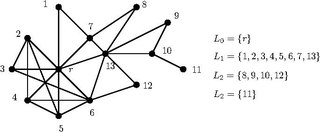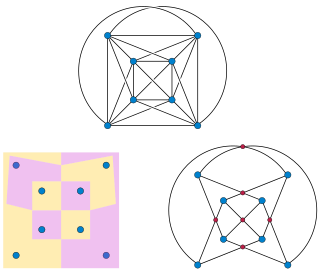
In graph theory, the shortest path problem is the problem of finding a path between two vertices in a graph such that the sum of the weights of its constituent edges is minimized.

Dijkstra's algorithm is an algorithm for finding the shortest paths between nodes in a weighted graph, which may represent, for example, road networks. It was conceived by computer scientist Edsger W. Dijkstra in 1956 and published three years later.
In the mathematical field of graph theory the Hamiltonian path problem and the Hamiltonian cycle problem are problems of determining whether a Hamiltonian path or a Hamiltonian cycle exists in a given graph. Both problems are NP-complete.

In the mathematical subfield of graph theory a level structure of an undirected graph is a partition of the vertices into subsets that have the same distance from a given root vertex.
In computer science, a fusion tree is a type of tree data structure that implements an associative array on w-bit integers on a finite universe, where each of the input integer has size less than 2w and is non-negative. When operating on a collection of n key–value pairs, it uses O(n) space and performs searches in O(logwn) time, which is asymptotically faster than a traditional self-balancing binary search tree, and also better than the van Emde Boas tree for large values of w. It achieves this speed by using certain constant-time operations that can be done on a machine word. Fusion trees were invented in 1990 by Michael Fredman and Dan Willard.
The Fulkerson Prize for outstanding papers in the area of discrete mathematics is sponsored jointly by the Mathematical Optimization Society (MOS) and the American Mathematical Society (AMS). Up to three awards of $1,500 each are presented at each (triennial) International Symposium of the MOS. Originally, the prizes were paid out of a memorial fund administered by the AMS that was established by friends of the late Delbert Ray Fulkerson to encourage mathematical excellence in the fields of research exemplified by his work. The prizes are now funded by an endowment administered by MPS.

Linear probing is a scheme in computer programming for resolving collisions in hash tables, data structures for maintaining a collection of key–value pairs and looking up the value associated with a given key. It was invented in 1954 by Gene Amdahl, Elaine M. McGraw, and Arthur Samuel and first analyzed in 1963 by Donald Knuth.
Prof. Athanasios K. Tsakalidis is a Greek computer scientist, a professor at the Graphics, Multimedia and GIS Laboratory, Computer Engineering and Informatics Department (CEID), University of Patras, Greece.

Cuckoo hashing is a scheme in computer programming for resolving hash collisions of values of hash functions in a table, with worst-case constant lookup time. The name derives from the behavior of some species of cuckoo, where the cuckoo chick pushes the other eggs or young out of the nest when it hatches in a variation of the behavior referred to as brood parasitism; analogously, inserting a new key into a cuckoo hashing table may push an older key to a different location in the table.

Kurt Mehlhorn is a German theoretical computer scientist. He has been a vice president of the Max Planck Society and is director of the Max Planck Institute for Computer Science.
In computer science, a family of hash functions is said to be k-independent, k-wise independent or k-universal if selecting a function at random from the family guarantees that the hash codes of any designated k keys are independent random variables. Such families allow good average case performance in randomized algorithms or data structures, even if the input data is chosen by an adversary. The trade-offs between the degree of independence and the efficiency of evaluating the hash function are well studied, and many k-independent families have been proposed.
In computer science, integer sorting is the algorithmic problem of sorting a collection of data values by integer keys. Algorithms designed for integer sorting may also often be applied to sorting problems in which the keys are floating point numbers, rational numbers, or text strings. The ability to perform integer arithmetic on the keys allows integer sorting algorithms to be faster than comparison sorting algorithms in many cases, depending on the details of which operations are allowed in the model of computing and how large the integers to be sorted are.

In graph algorithms, the widest path problem is the problem of finding a path between two designated vertices in a weighted graph, maximizing the weight of the minimum-weight edge in the path. The widest path problem is also known as the maximum capacity path problem. It is possible to adapt most shortest path algorithms to compute widest paths, by modifying them to use the bottleneck distance instead of path length. However, in many cases even faster algorithms are possible.
In computer science, tabulation hashing is a method for constructing universal families of hash functions by combining table lookup with exclusive or operations. It was first studied in the form of Zobrist hashing for computer games; later work by Carter and Wegman extended this method to arbitrary fixed-length keys. Generalizations of tabulation hashing have also been developed that can handle variable-length keys such as text strings.

Mihai Pătrașcu was a Romanian-American computer scientist at AT&T Labs in Florham Park, New Jersey, USA.
In combinatorial mathematics and theoretical computer science, heavy path decomposition is a technique for decomposing a rooted tree into a set of paths. In a heavy path decomposition, each non-leaf node selects one "heavy edge", the edge to the child that has the greatest number of descendants. The selected edges form the paths of the decomposition.
In computing, a distance oracle (DO) is a data structure for calculating distances between vertices in a graph.

In graph theory, a branch of mathematics, a map graph is an undirected graph formed as the intersection graph of finitely many simply connected and internally disjoint regions of the Euclidean plane. The map graphs include the planar graphs, but are more general. Any number of regions can meet at a common corner, and when they do the map graph will contain a clique connecting the corresponding vertices, unlike planar graphs in which the largest cliques have only four vertices. Another example of a map graph is the king's graph, a map graph of the squares of the chessboard connecting pairs of squares between which the chess king can move.
In computer science, the predecessor problem involves maintaining a set of items to, given an element, efficiently query which element precedes or succeeds that element in an order. Data structures used to solve the problem include balanced binary search trees, van Emde Boas trees, and fusion trees. In the static predecessor problem, the set of elements does not change, but in the dynamic predecessor problem, insertions into and deletions from the set are allowed.
Rasmus Pagh is a Danish computer scientist and a professor of computer science at the University of Copenhagen. His main work is in algorithms and data structures, and he is particularly known for the cuckoo hashing algorithm and for co-founding the Basic Algorithms Research Center, BARC, in Copenhagen.








